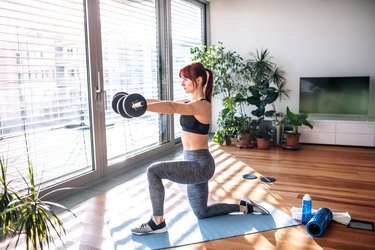
When learning how to get muscle definition, the equation can be quite simple: Build strong muscle while achieving or maintaining a healthy body fat percentage that lets those muscles shine.
And, fortunately, if you're wondering exactly how to get muscle definition as a woman, neither building muscle or burning fat require an intense workout routine or rigid diet. Instead, by balancing your strength and cardio workouts along with a healthy diet can help you increase muscle definition throughout your body.
Video of the Day
Video of the Day
Strength Training to Get Muscle Definition
"The biggest key to building muscle definition is your strength training," says certified personal trainer Carolina Araujo.
It's a common misconception that lifting heavy weights will cause a woman to "bulk up." However, women don't testosterone levels that are near as high as men's, meaning it takes intense, dedicated size-based training for women to drastically increase muscle size. Unless you train in a way that's really specific to building size, strength training is going to make women look more defined as opposed to "bulky," according to the National Academy of Sports Medicine.
If you're new to strength training or have limited time in the gym, filling your lifting sessions with compound exercises is a good place to start. Compound exercises work several muscle groups at once, boost calorie burn and help improve movement efficiency, according to the American Council on Exercise. Deadlifts, squat thrusts and renegade rows are just a few compound exercises to incorporate into your routine.
Another important element to achieving muscle gains is consistency, per the ACE. Women should aim to weight train four to five days a week, if possible. Just be sure you are allowing at least one full day of recovery between training specific muscle groups.
As your strength grows, increase the amount of weight you're lifting over time, too, Araujo says. Gradually increasing your weight, sets and reps (forms of progressive overload) will help you continue to build lean muscle and get the muscle definition you're looking for.
Related Reading
Cardio Exercise to Increase Muscle Definition
Unless you already have a lean physique, you'll need to shed a little fat to reveal the muscle you've developed through strength training. And that's where cardio comes into play. (While cardio can slightly increase muscle mass, strength training is ideal for packing on muscle.) Cardio can add to your overall calorie burn, helping you shed fat, according to the ACE.
Aim for at least 150 minutes of moderate cardio (like jogging or biking) activity or 75 minutes of intense cardio (like sprint intervals) each week, suggests the American Heart Association (AHA). This is an excellent baseline for overall heart health and can help spur weight loss.
Even after you've achieved your fat-loss goal, you'll want to keep your aerobic activity consistent to maintain your body fat percentage over time and promote better health. So, choose the forms of cardio you enjoy the most. Biking, running, walking, using the elliptical and HIIT are some fun ways to work up a sweat and burn fat.
Related Reading
Nutrition for Muscle Definition
Alongside a consistent workout routine, your diet also plays an important role in how to get muscle definition. After all, if your goal is to build lean muscle and burn fat, it's going to be a challenge if your eating habits aren't in check.
Building muscle actually requires more protein than maintaining muscle. The American College of Sports Medicine (ACSM) recommends that women eat about 1.2 to 1.7 grams of protein per kilogram of their body weight per day. For a 140-pound woman, that works out to between 76 grams and 107 grams of daily protein.
Eating some lean protein with every meal is a great way to ensure you're meeting your daily intake goal. Poultry, fish, low-fat dairy, eggs, beans, nuts and seeds are all great examples of lean protein you can easily incorporate into your diet, according to the ACSM.
Pair your protein with plenty of whole carbs, too. Carbohydrates are another important part of the muscle-building process. Carbs are converted into glycogen, which is stored in the muscles and used to power you through your workouts, according to the Academy of Nutrition and Dietetics.
Incorporate high-quality, whole carbs that are low in fat, like brown rice, whole-grain bread or pasta and quinoa, suggests the Academy of Nutrition and Dietetics.
Vegetables can also be a great source of whole carbs. They also deliver a haul of fitness-boosting vitamins and minerals, fiber included. Fiber helps keep your blood sugar levels stable, promotes regular digestion and helps boost satiety levels.
- American Heart Association: “American Heart Association Recommendations for Physical Activity in Adults and Kids”
- American Council on Exercise: “A Girls Guide To Gaining Muscle: Weight Training”
- American Council on Exercise: "Benefits of Compound Exercises"
- Academy of Nutrition and Dietetics: "4 Keys to Strength Building and Muscle Mass"
- American College of Sports Medicine: "Protein Intake for Optimal Muscle Maintenance"
- National Academy of Sports Medicine: "5 Fitness Myths — Busted!"
- American Council on Exercise: "I’ve Heard That Performing Aerobic Workouts at a Low Intensity is Best for Losing Body Fat - is That True?"